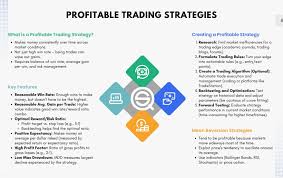Swing trading, a technique employed in the stock market, is designed to capture short- to medium-term gains. This trading strategy seeks to benefit from price swings within a trend. The methodology relies on technical analysis and careful timing.
Basics of Swing Trading
Swing trading is characterized by holding positions for a few days to several weeks. The objective is to capitalize on market swings or fluctuations. Traders analyze price movements and patterns to identify potential opportunities. Technical indicators, such as moving averages, relative strength index (RSI), and candlestick patterns, are frequently used.
Technical Analysis in Swing Trading
Technical analysis forms the backbone of swing trading strategies. Historical price data and chart patterns are scrutinized to forecast future price movements. Trendlines and support/resistance levels are plotted to gauge potential price points. Moving averages, both simple and exponential, are often employed to identify trends and potential reversal points.
Trade Execution
Entry and exit points are determined based on the analysis of charts and technical indicators. Positions are established when a trading signal is generated. Signals can include breakouts from key levels, candlestick formations, or momentum shifts. Stop-loss orders are used to limit potential losses, while profit targets are set to lock in gains.
Risk Management
Effective risk management is essential in swing trading. Capital preservation is prioritized by limiting the size of individual trades and employing stop-loss orders. Position sizing is carefully calculated to mitigate the impact of adverse price movements. Diversification across different stocks or sectors may also be practiced to reduce risk.
Swing Trading Strategies
Various strategies are employed within swing trading, each catering to different market conditions and trading styles. Some common strategies include:
- Trend Following: Trades are taken in the direction of the prevailing trend. Buy positions are established in uptrends, while sell positions are initiated in downtrends. Indicators like moving averages and trendlines guide these trades.
- Range Trading: This strategy involves identifying stocks that are trading within a defined range. Buy positions are taken near the support level, and sell positions are initiated near the resistance level. The goal is to profit from price oscillations within the range.
- Breakout Trading: Breakouts occur when a stock price moves beyond a significant support or resistance level. Positions are established as the price breaks out of the established range, with the expectation of continued momentum in the direction of the breakout.
- Reversal Trading: This strategy focuses on identifying potential reversal points in the market. Reversal patterns, such as head and shoulders or double tops/bottoms, are used to anticipate changes in the direction of the price movement.
Common Mistakes in Swing Trading
Several mistakes are commonly observed among swing traders. Emotional decision-making can lead to impulsive trades and poor risk management. Overtrading or taking excessive risks can erode capital. Inadequate research or reliance on unverified signals can result in unfavorable outcomes. It is crucial to maintain discipline and adhere to a well-defined trading plan.
Advantages of Swing Trading
Swing trading offers several advantages, including:
- Flexibility: Traders have the freedom to hold positions for days or weeks, allowing for flexibility in managing trades around other commitments.
- Potential for Significant Gains: By capturing short- to medium-term price movements, traders can achieve substantial gains within a relatively short period.
- Reduced Exposure: Compared to long-term investing, swing trading involves shorter holding periods, reducing exposure to market risk over time.
Disadvantages of Swing Trading
However, swing trading also presents some disadvantages:
- Market Volatility: Shorter holding periods expose traders to market volatility and potential price swings.
- Emotional Stress: The need to constantly monitor the market and make quick decisions can create emotional stress for traders.
- Transaction Costs: Frequent trading can result in higher transaction costs, which may impact overall profitability.
Strategies for Making Quick Profits

In the world of finance and business, the pursuit of quick profits often entices many. Various strategies have been devised to achieve rapid financial gains, each leveraging different aspects of market behavior, technology, and investment tactics. The effectiveness of these strategies may vary, but a general overview can provide insights into their application and potential benefits.
1. Day Trading
Day trading has become popular among those seeking to profit quickly from short-term market fluctuations. Stocks, currencies, and commodities are typically bought and sold within the same trading day. The aim is to capitalize on the volatility of the markets. Positions are often held for minutes to hours rather than days or weeks. Technical analysis tools and charts are employed to predict price movements and identify trading opportunities. Risk management strategies, including stop-loss orders, are crucial to mitigate potential losses.
2. Forex Trading
The foreign exchange (forex) market, known for its high liquidity and 24-hour trading, offers opportunities for quick profits. Currencies are traded in pairs, and traders speculate on the fluctuations in exchange rates. Leveraged trading is common, allowing traders to control larger positions with a smaller amount of capital. While significant profits can be made, the risks are also considerable. Therefore, a thorough understanding of the forex market and trading strategies is essential.
3. Cryptocurrency Investments
The cryptocurrency market has gained notoriety for its rapid price swings and potential for substantial returns. Bitcoin, Ethereum, and other cryptocurrencies are often traded on various exchanges. Speculative trading, coupled with technological advancements and market news, can lead to swift profits. However, the market’s volatility requires investors to stay informed and be prepared for abrupt changes in value. Risk management techniques, such as diversifying investments and setting profit targets, are recommended.
4. Real Estate Flipping
In real estate, properties are bought, renovated, and sold for a profit in a relatively short period. This strategy, known as house flipping, involves identifying undervalued properties, making necessary improvements, and selling them at a higher price. The success of this strategy depends on market conditions, renovation costs, and the ability to sell the property quickly. Accurate market analysis and budgeting are crucial to ensure profitability.
5. Affiliate Marketing
Affiliate marketing offers a way to earn commissions by promoting other companies’ products or services. Affiliates use various channels, such as websites, blogs, or social media, to drive traffic to the merchant’s site. Commissions are earned on sales generated through the affiliate’s referral links. Quick profits can be achieved if the marketing efforts are effectively targeted and the products or services are in high demand.
6. Online Arbitrage
Online arbitrage involves buying products from online retailers at a lower price and reselling them on other platforms at a higher price. This strategy takes advantage of price discrepancies across different e-commerce platforms. Research and monitoring tools are utilized to identify profitable opportunities. Success depends on the ability to find and act on these price differences swiftly.
7. Dropshipping
Dropshipping is an e-commerce model where the retailer does not hold inventory. Instead, products are purchased from a third-party supplier who ships them directly to the customer. The retailer earns a profit from the difference between the wholesale and retail prices. This model allows for quick setup and operation, but competitive pricing and effective marketing are necessary to drive sales and generate profits.
8. High-Yield Savings Accounts
For those seeking a lower-risk strategy, high-yield savings accounts offer better interest rates than traditional savings accounts. Funds are deposited into accounts that provide higher returns, allowing for quicker accumulation of interest. While not as lucrative as other strategies, high-yield savings accounts provide a safer way to earn profits without significant risk.
9. Peer-to-Peer Lending
Peer-to-peer (P2P) lending platforms connect borrowers with investors willing to lend money. Investors earn interest on the loans they provide. The potential for quick profits exists if the loans are repaid promptly and at higher interest rates. However, the risk of borrower default must be considered. Diversifying investments across multiple loans can help manage risk.
10. Short Selling
Short selling involves borrowing and selling a security with the expectation that its price will decline. The security is later bought back at a lower price, and the difference between the selling and buying prices constitutes the profit. This strategy requires a thorough understanding of market trends and potential risks. Short selling can lead to significant losses if the market moves against the position.
Conclusion
Swing trading, with its focus on capturing short- to medium-term price movements, offers both opportunities and challenges. By employing technical analysis, managing risk effectively, and adhering to well-defined strategies, traders can navigate the complexities of the stock market. Continuous learning and adaptation are vital for success in swing trading, as market conditions and strategies evolve over time.










